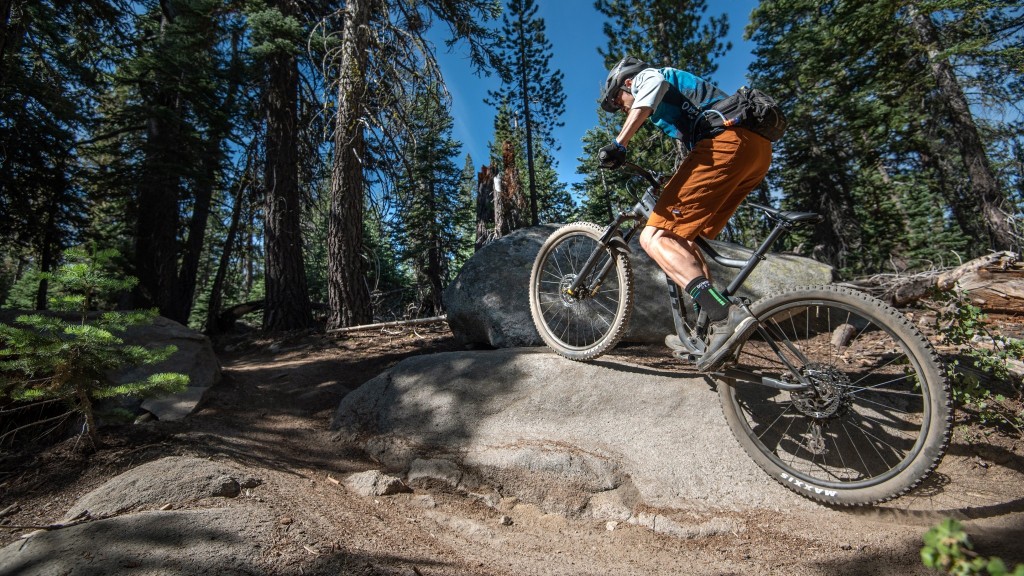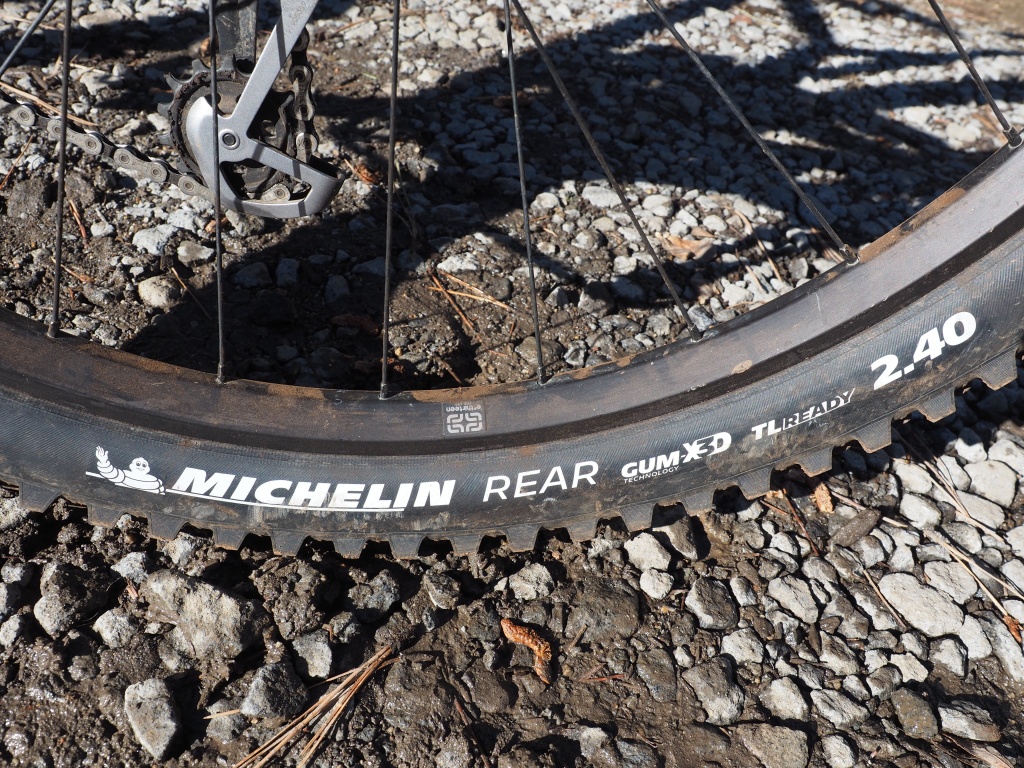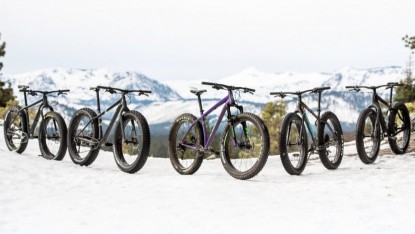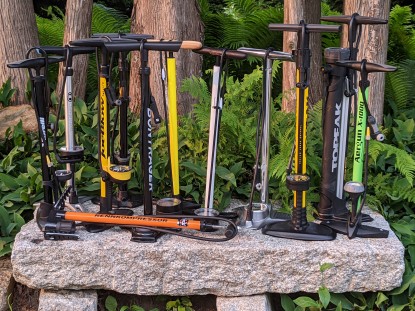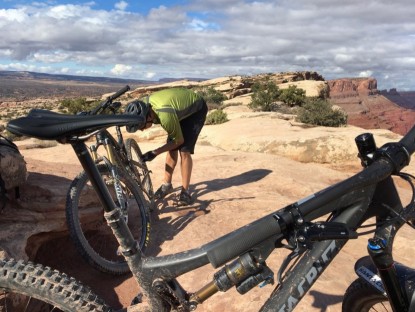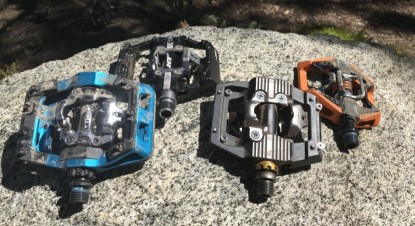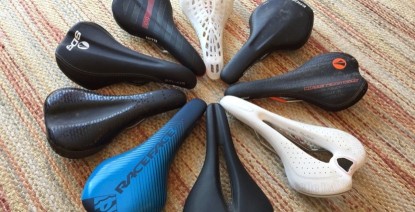Mountain Bike Tire Considerations
Except during the unfortunate event of a crash, your tires are the ONLY part of your bike that actually touch the trail. Everything you do atop your bike, from churning the pedals, to body position, and weight distribution, translates down to the tires. You can do everything else right, but the wrong set of skins can thwart your efforts like nothing else. A proper set of tires that suits your riding style and the terrain you ride most often provides arguably the best cost-to-performance ratio of all bike upgrades.
A dropper post is right up there as well. If you're washing out on corners or slipping during steep climbs and you've already eliminated crappy technique from the equation, take a look at what tires you're running. If you're on a tubeless setup, blow off a couple psi and see if that helps. Rock hard tires are a thing of the past. Still all over the place and you're absolutely sure you don't just suck at riding a bike? Seriously, it's the tires.
As quickly as mountain bike technology evolves, we've become conditioned to think that shiny, lighter, more expensive, carbon fibery things are the key to enhanced riding performance that will make us faster than the next guy. With their lack of moving parts and propensity for the color black, tires lack shelf appeal. Proper size and lowest price are often the only purchase considerations for many riders. This needs to change.
Think about that time you cracked your skull on the icy sidewalk outside your office building because you were wearing hard-soled wingtips instead of your deep-lugged winter boots. Or remember that mid-November dump that made for a harrowing drive to the ski resort because you hadn't switched over to your snow tires yet? A good set of tires can instantly make your "OK" bike handle like a top-of-the-line race machine. The wrong set of tires can turn an $8000 enduro bike into something you'd hesitate to take out onto the bike path. So, ready to pull the trigger on some new rubber for your ride? Keep reading!
Tire Size
We'll start with the basics. It is imperative that you purchase a tire that will fit your wheel. Tire companies make the same model tire in a variety of sizes. Your buddy told you all about what tire he thinks is the one to buy, but you'll need more information than that. Luckily, it's probably right in front of your face.
Wheel SizeWheels are the metal things (or carbon if you're fancy) that your tires are mounted to. Tires are made of rubber and are the subject at hand. To avoid the mechanics at the local bike shop making fun of you after you leave, know the difference. Also, know they're probably making fun of you regardless. Mountain bike tires come in three different sizes; 26-inch (get with the program already), 27.5-inch also known as 650b if you want to trick the shop guy into thinking you know what you're talking about, and 29-inch. If you already have a tire on your wheel but aren't sure of the wheel size, it's the first number in this example: 27.5 X 2.3. If you only have the wheel, it's likely printed on there somewhere.
Tire Width
While a 26-inch tire won't work on a 29-inch wheel, you have some wiggle room with the second number after the "x" in the above example. This number represents the width in inches of the tire. Typically, mountain bike tire widths will range from 2.0 to 2.6 inches. Widths above 2.6 are the realm of "plus" or "fat" bike tires. Tires have been trending wider in recent years, and 2.5 and 2.6-inch models are now incredibly common.
Generally speaking, narrower tires will roll fast and are typically oriented towards cross-country riding. They won't perform nearly as well in rough and loose conditions. As an extreme example, imagine putting road bike tires on a mountain bike and riding your favorite downhill trail. Conversely, the increased contact patch provided by wider tires will increase grip and traction and will be more stable when moving fast over very rough terrain. It's always a good idea to check with the bike and/or fork manufacturer to see the maximum width tire that can safely be run on your particular bike. A tire that is too wide can rub against the suspension fork crown or your rear triangle causing excessive wear and jeopardizing your safety.
Tread Pattern
Short of actually riding a tire, just looking at a tire's tread can give you a decent sense of how it might perform. Big, widely spaced knobs will bite into wet soil and shed mud well. Small, tightly spaced nubs will roll fast and provide lots of contact on hard packed soil or rock slabs. The knobs that run down the center of the tire provide traction during pedaling and braking, while the lugs on the sides of the tire engage during turns to provide grip and stability. The rest of the 'tweeners provide a smooth transition when the bike is leaned into turns and brought back upright. You'll notice the leading edge of many of the knobs are ramped to reduce rolling resistance. The direction of rotation is typically marked on the tire's sidewall.
Rubber Compounds
There are a number of proprietary rubber compounds out there and each manufacturer will claim theirs is undeniably the best. The hardness of rubber, or durometer, is measured in Shore A, which is abbreviated with a small a. On this scale of 1-100, soft tires are somewhere around 45a and hard tires up to 70a. Often times, a particular model tire is available in different rubber compounds. Generally, tires made from softer rubber will provide exceptional grip, but tend to wear out much faster, especially when ridden on pavement or very firm surfaces.
Even with great trail access right from our office in South Lake Tahoe, we still put plenty of miles on pavement just getting to our daily rides. If you're the type that rides from your doorstep, a harder durometer tire may be a good choice. Save the soft stuff for racing. Conversely, if you're a shuttle-bunny adverse to pedaling uphill that typically burns more dinosaurs than calories driving your bike around, softer tires may be a good bet. To combat the issue a bit, manufacturers often use dual, or even triple rubber compounds in the same tire. Harder rubbers are used on the middle knobs and softer rubbers for the side knobs. This provides a good balance of grip and durability. Different brands use different names for their various rubber compounds. Examples include Schwalbe's Addix Speedgrip and Addix Soft, and WTB's Fast Rolling and High Grip.
Front and Rear
While plenty of riders choose a matched pair of tires for both wheels, we feel there is good argument to run a different tire for each. Many tires have been optimized for use on either the front or back wheel, although you're likely to see some riders out on the trail riding them otherwise.
Front tires
The front tire is responsible for the bulk of the cornering and needs to respond appropriately to the forces translated to it in order to remain on your intended line. A wider front tire will also help you stay on course, as more of the tire is in contact with obstacles, and will deflect less than a narrower tire. Front tires often feature substantial rows of shoulder lugs for confident cornering and directional center tread knobs to improve rolling resistance. A front tire does not suffer as much drag and therefore it is common to see riders elect to mount a big knobby tire up front and a smoother looking tire for the rear. In fact, many riders simply run worn-out front tires as rear tires. We feel differences in tread pattern and knob spacing make a rear specific tire a better bet, but alas, it's not the worst option and easier on the wallet.
Rear tires
Rear tires are directly responsible for pedaling traction, take the brunt of the braking forces, and play a role in cornering. Rear specific tires come in a huge variety of tread designs for specific riding styles, terrain, and conditions. Tires designed for aggressive riding or loose conditions will typically have large shoulder knobs for cornering paired with large center tread lugs with squared-off edges to dig into the surface when pedaling or the brakes are applied. On the other end of the spectrum, semi-slick designs prioritize rolling speed and feature short and tightly packed center tread knobs and substantial shoulder knobs. Semi-slicks have less drag and rolling resistance and work very well in dry and firm conditions, but they falter things get loose or muddy. Of course, there are tires made for every application from XC racing to downhill. What works best for you will depend on where and how you ride.
Casings
TPI
There's a lot more technology going on in a tire than it appears. Did anyone else get scolded by their parents for leaving 20-foot skid marks on the driveway by locking up that coaster brake at top speed on your first bike? Well, after an afternoon of driveway graffiti skid school, you might have succeeded in wearing a rear tire down to the "threads." Those nylon strands you managed to expose form the casing of a tire.
Just like those Egyptian cotton sheets, tires have a thread count too. Measured in tpi (threads per inch), usually the higher the thread count, the lighter the tire because less rubber is required to fill the matrix created by the casing. More isn't always better though, as a higher tpi, although lighter, can make for a weaker sidewall. Various types of reinforcement are added to tires in order to beef up sidewall and tread puncture resistance.
ArmoringSometimes just an additional "ply" of nylon casing is used to reinforce a tire. Materials such as Kevlar can be used as well to reinforce sidewalls and make a tire more robust, although the rolling efficiency of the tire may be altered. "Belting" incorporates strips of material under the tire tread to increase puncture resistance. A full cap of material can run from bead to bead to provide protection across the entire tire. As rim internal diameters grow and allow riders to run lower and lower tire pressures, tire beads must be reinforced to insure an air tight seal and prevent "burping." Different brands have different names for their casings and additional protection. Examples include Maxxis with EXO, EXO+, and Double Down, and Specialized with Control, GRID, GRID Trail, and DH.
Tubeless
Conclusion
There's a lot to consider when purchasing new mountain bike tires. One thing is certain, it is one of the least expensive ways to improve the ride quality and performance of your mountain bike. Match your tire selection with your riding style, terrain, and conditions, and get out and ride.


